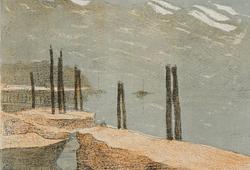Anders Zorn
"Märta"
Signed Zorn and dated 1917. Canvas 101 x 64.5 cm.
Import VAT
Import VAT (12%) will be charged on the hammer price on this lot. For further details please contact customer service +46 8-614 08 00.
Provenance
Consul Helge Ax:son Johnson's collection, Berga Castle.
Bukowski Auktioner AB, "Helge Ax:son Johnsons samling", 1942, illustrated full page 26, cat. no. 62.
Literature
Gerda Boëthius, "ZORN. Tecknaren. Målaren. Etsaren. Skulptören", included in the catalog section for the year 1917, p. 555.
Albin Roosval (ed.), "Svenska slott och herresäten, Södermanland", 1923, mentioned on p.114 and illustrated p. 116.
illustrated full page 169.
Albert Engström, "Anders Zorn", 1932, illustrated full page p. 169.
Anita och Bo Stjernström, "Bergakungen och hans Slott", Västerhaninge, 2011, illustrated p. 96 and 97.
More information
In the late 1880s, during his summer visits to Dalarö, Anders Zorn began to depict the naked female body in the sunny archipelago landscape. He came back to this theme, sometimes referred to as "naket i det fria" (nude in the open air), throughout the rest of his career and brought him great success and fame. Around the year 1910, Gerda Boëthius suggests that one can see a revival in Zorn's paintings. She believes that during this time, you can see "a new phase where both subject matter and painting have something new, and the color has acquired a special tone with a preference for pink. In his archipelago paintings, he returned with affection to the subjects of his youth, where water and cliffs are the environment. [...] He filled the canvas with finely distributed tones, planes, values, and form, so that one can 'read his paintings' like a musician reads a score. His color palette is sometimes even more puritanical than in his youth. He often creates lighting effects with scraping or extremely thin paint."
The cosmopolitan Zorn moved far beyond the country's borders and was by no means limited to staying in either Mora or the archipelago. However, this was to change with the outbreak of the First World War. The new global situation led to disruptions in the artist's international relations, which had a significant impact on his life as he became increasingly settled in Mora. The year was now divided with a greater regularity between Mora/Gopsmor, Stockholm, and the archipelago.
In the following years, Zorn executed a series of nude studies against a picturesque backdrop of water and cliffs. Despite the breakthrough of "modern" art and occasional criticism, Zorn could take pleasure in presenting himself to the broader public as a national painter. Zorn's subjects remained in high demand, and collectors and buyers continued to eagerly await his works. Boëthius writes: "Both 1917 and 1918 were good years for work, and although he was criticized by the 'modern' group, he had the joy of being repeatedly encouraged by other comrades, whom he held in high esteem. On November 1, 1918, Carl Larsson wrote: 'If my admiration for you, Anders, could increase, it has done so since I saw your latest works...'."
"Märta" was painted in 1917 and was previously part of Consul Helge Ax:son Johnson's significant collection of Anders Zorn's paintings. In Ax:son Johnson's impressive residence, Berga Castle, the painting was placed in the consul's study along with two other Zorn motifs from 1917: "Werners eka" and "Helga."
The painting 'Märta' was later moved and placed in the Upper Hall together with a large number of Zorn's paintings and etchings. To the right of 'Märta' is 'Gondola, Venice', a watercolour painted during Anders and Emma Zorn's visit to Isabella Stewart Gardner in Venice in 1894 (see image).
Artist
Anders Zorn, born in Mora in 1860, showed artistic talent from a young age. In 1875, he traveled to Stockholm and became a student at the then Slöjdskolan (now Tekniska högskolan) in Stockholm, and shortly after, he joined the Royal Academy of Fine Arts. Initially, Zorn had aspirations of becoming a sculptor, but soon watercolor painting took over, becoming his primary medium until 1887. At the student exhibition in 1880, Zorn had his breakthrough with the watercolor painting "I sorg." The following year, he gained international acclaim as a portrait painter. His watercolor painting reached its pinnacle during this period, and his most famous work from this time is "Vårt dagliga bröd” from 1886. Shortly thereafter, Zorn transitioned to oil painting, which was met with immediate success. Zorn's reputation mainly rested on his portrait art, and he portrayed many notable figures, including presidents. For instance, he created an etching of Theodore Roosevelt. His etchings significantly contributed to his success. In the late 1880s, Zorn began working in the genre that would increasingly become his trademark: nude figures in outdoor settings. He had long been fascinated by the movement of water and the reflections of light on its surface. Now, he added the complexity of placing a model near or in the water, aiming to depict a synthesis between nature and humanity. In 1896, Zorn and his wife moved back to Sweden and settled in Zorngården in Mora. This move sparked a renewed interest in his homeland, which would be reflected in his future paintings. Among the artist's scenes from the Mora region, portraying its local customs and ancient traditions, "Midsommardansen" holds the highest value according to Zorn himself. Today, the painting can be found at the National Museum.
Read more
























































